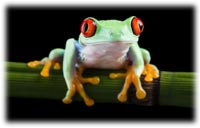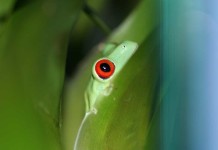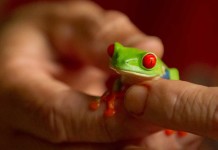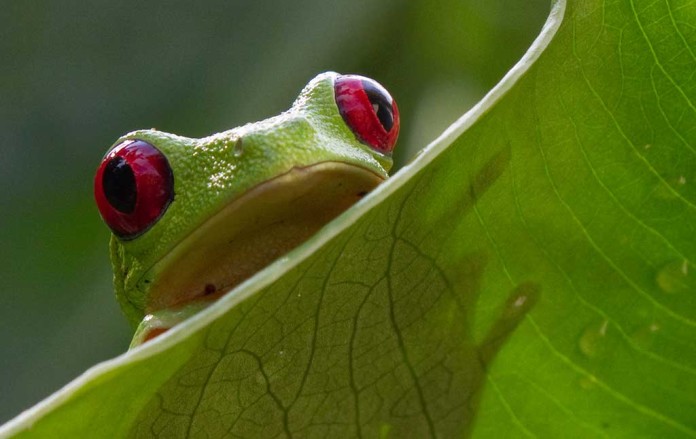The red eyed tree frog is a modern-day symbol of rainforest preservation and one of the most photographed species alive. They are a marvel of flashy color and stealth movement. The red eyed tree frog habitat is in the tropical rainforests throughout Central America and southern Mexico. They spend the majority of time in tall treetops among dense vegetation in lowland areas near rivers and lakes where they can keep their skin moist.
Survival in its Habitat
The red eyed tree frog thrives in temperatures between 75-85o during the day and between 66-77o by night. They require a high humidity of 80-100%. If you look closely in the daytime you can see them clinging to branches, tree trunks, leaves and even the underside of leaves with their suctioned toes.
To keep themselves safe from predators during the day, they hide their colorful blue and yellow sides, bright blue legs and orange toes under themselves. Their vibrant red eyes are concealed with a third eyelid, called a nictitating membrane, which shields the eye without blocking the frog’s sight.
At night, the carnivorous red eyed tree frog feeds. They lay in wait for prey to cross their path. Insects are varied and plentiful in the frog’s habitat, so mealtime offers a multiple feeding of crickets, moths, flies, grasshoppers and smaller frogs.
A Habitat in Danger
 These frogs serve as a meter by which their habitat can be gauged. They, along with other amphibian species, can alert us to environmental changes in their environment sooner than other animals. This gives us a great indicator of threats to the rainforest the red eyed tree frog calls home.
These frogs serve as a meter by which their habitat can be gauged. They, along with other amphibian species, can alert us to environmental changes in their environment sooner than other animals. This gives us a great indicator of threats to the rainforest the red eyed tree frog calls home.
They are not endangered or in immediate threat. However, the red eyed tree frog habitat faces many dangers that could threaten their survival. This includes global warming, climatic and atmospheric changes, wetland drainage and pollution. On a greater scale, the loss of rainforest habitat due to deforestation for farming and industrialism greatly influences the red eyed tree frog population.
A very recent threat has taken root in the form of a deadly fungus that is spreading. The fungus attacks the delicate skin of these amphibians. As of yet, researchers have not developed a way to control the fungus and much is still unknown about the disease as it exists in the red eyed tree frog habitat.
Many zoos and aquariums have attained reserve populations of the red eyed tree frog in order to preserve and raise awareness for their declining habitat. Scientists have taken steps to preserve the species through the Amphibian Conservation Action Plan. Efforts are being taken worldwide to preserve the natural habitat of these creatures and, in doing so, helping all species including humans.













